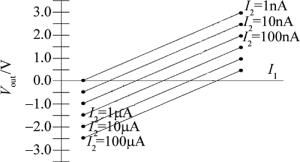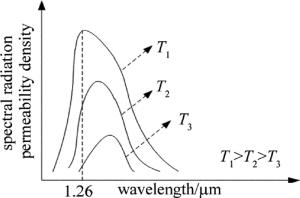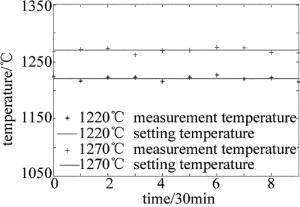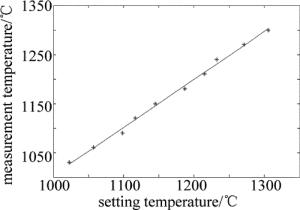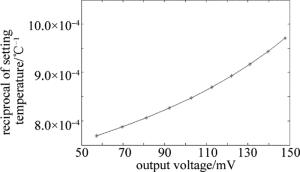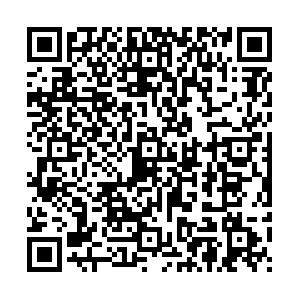-
过去主要采用两种方式来检测热风炉拱顶温度。一种是采用铂铑-铂热电偶检测热风炉拱顶温度,其为接触式测温方法[5-6],优点是精度高,但存在几点缺陷:(1)反应速度慢,主要是因为保护管性能差导致的;(2)热电偶安装操作不方便;(3)工作寿命短[7],热风炉拱顶内含有大量的CO气体,而CO具有还原性,极易腐蚀热电偶,增加了后期维护成本。
另一种是采用单波段红外光纤检测热风炉拱顶温度,其为非接触式测温方法[8-9],即通过测温探头来测量被测物发出的红外辐射来检测温度。若采用此种方式测温,需解决两个影响测温结果的重要因素:(1)发射率。根据斯忒潘-玻尔兹曼定律[10]得出黑体在单位时间内发出的热辐射能量为W=εσT4,其中,T为绝对温度,σ为斯忒潘-玻尔兹曼常量, ε为发射率,通常小于1。影响发射率的因素很多,它不仅跟被测物体的形状、粗糙程度、表面氧化层、凹凸程度、表面杂质有关[11],还与被测物方向有关,因此发射率ε不能准确求出; (2)环境。设被测物温度与环境温度分别是T1和T2,物体的发射率与吸收率分别为ε1和ε2,单位面积为A,根据斯忒潘-玻尔兹曼定律得出物体发出的净辐射能量[12-14]为W=Aσ(ε1T14-ε2T24),高炉热风炉环境温度很高,因此对测温结果造成很大影响;其次由于探头会被粉尘、水蒸汽等污染[15],降低探头的透明性,影响测温精度。
针对以上传统热风炉拱顶测温方法的不足,作者提出了基于双波段对数比放大测温系统,本系统无需考虑发射率ε的大小,且对数比放大的输出电压与真实温度的倒数呈线性关系,这极大地提高了实验结果的准确性,同时对现场环境要求没有那么苛刻,减少了后期现场维护,节约成本。
-
蓄热室是热风炉进行热交换的主体,它由格子砖砌筑而成。砖的表面就是蓄热室的加热面,格子砖就是贮存热量的介质[16]。因此,只需检测格子砖温度就可知道热风炉内真实温度。当处于受热情况的拱顶格子砖辐射的能量经大气媒介传输给红外测温仪时,内部的光学系统将目标辐射的能量汇聚到红外探测器上,并转换为电信号,再通过一系列的信号处理过程,最终在终端上显示热风炉拱顶温度。流程图如图 1所示, 整个系统主要由光电传感器、对数比放大器、模数转换器以及显示终端等构成。
在给定温度与波长的条件下,能够全部吸收外部能量,且又能辐射自身全部能量,称为黑体,其发射率为1,吸收率为1。将其它发射率与吸收率都小于1的物体称之为灰体。根据普朗克定律可以得出黑体的光谱辐射功率P(λ, T)与绝对温度T的数学表达式[17]:
$ P\left( \lambda , T \right)={{c}_{1}}{{\lambda }^{-5}}\frac{1}{\text{exp}[{{c}_{2}}/\left( \lambda T \right)]-1~} $
(1) 式中,P(λ, T)为黑体的辐射功率,λ为波长,T为绝对温度,c1为第一辐射常数,c2为第二辐射常数。
光电检测方法具有精度高、响应时间短、非接触等优点,传感器的结构简单,形式灵活多样。光电传感器是各种光电检测系统中实验光电转换的关键元件,它可把光信号(红外、可见及紫外光辐射)转变为电信号的器件[18]。本文中选用的光某公司生产的LY-HWZ型光电传感器,其输出电流为0mA~20mA,响应时间为1ms,测温范围700℃~1600℃,测温范围10m±10%,而格子砖上部与拱顶外顶部相距8684mm[19],满足工业需求。其光电转换满足以下关系式, 输出电流为:
$ {I_{{\rm{out}}}} = KP(\lambda , T) $
(2) 式中,K为光电传感器的光电探测系数。
实验中选择对数比放大芯片LOG112来处理电流信号,可防止测温探头周围环境污染带来的干扰。其输入电流范围为100pA~3.5mA,精度0.2%,芯片内部具有2.5V的基准电压,满量程最大输出电压可达3.5V,满足实验需求。LOG112输出电压与电流I1,I2之间的关系如图 2所示。当测温探头受到水蒸汽或者粉尘干扰,使得测温探头能见度降低,这时会影响单波段测温的发射率,从而导致测温结果不准确,但对于双波段对数比测温,由于两个波段受到的影响是一致的,二者的比值则不受影响。其对数比放大公式如下:
$ {V_{{\rm{out}}}} = 0.5{\rm{lg}}\left( {\frac{{{I_1}}}{{{I_2}}}} \right) $
(3) 则由(1)式~(3)式得出Vout为:
$ {V_{{\rm{out}}}} = 0.5{\rm{lg}}\left[ {\frac{{{K_1}{c_1}{\lambda _1}^{ - 5}\frac{1}{{{\rm{exp}}\left( {\frac{{{c_2}}}{{{\lambda _1}T}}} \right) - 1}}}}{{{K_2}{c_1}{\lambda _2}^{ - 5}\frac{1}{{{\rm{exp}}\left( {\frac{{{c_2}}}{{{\lambda _2}T}}} \right) - 1}}}}} \right] $
(4) 由于$ {\rm{exp}}\left( {\frac{{{c_2}}}{{{\lambda _1}T}}} \right) \gg 1$和${\rm{exp}}\left( {\frac{{{c_2}}}{{{\lambda _2}T}}} \right) \gg 1$,则:
$ \begin{array}{l} {V_{{\rm{out}}}} = 0.5{\rm{lg}}\left\{ {\frac{{{K_1}{\lambda _2}^5{\rm{exp}}\left[ {{c_2}/\left( {{\lambda _2}T} \right)} \right]}}{{{K_2}{\lambda _1}^5{\rm{exp}}\left[ {{c_2}/\left( {{\lambda _1}T} \right)} \right]}}} \right\} = \\ 0.5\frac{{{c_2}}}{T}{\rm{lg}}\left[ {{\rm{exp}}\left( {\frac{{{\lambda _1} - {\lambda _2}}}{{{\lambda _1}{\lambda _2}}}} \right)} \right] + 0.5{\rm{lg}}\left( {\frac{{{K_1}{\lambda _2}^5}}{{{K_2}{\lambda _1}^5}}} \right) \end{array} $
(5) 从(5)式可以看出,当光电传感器选定,则K1,K2,λ1,λ2都为定值,Vout与1/T呈线性关系。
在对LOG112输出电压进行处理时,需要用到模数转换器,它能把输出电压转换为对应数值。实验中选用的模数转换器为AD7799,它是一种高精度的24位模数转换器,非线性度为0.0015%,工作环境温度为-40℃~105℃,符合热风炉周围环境温度。根据AD7799芯片手册可知,该芯片数字量输出为Dout。
单极性:
$ {D_{{\rm{out}}}} = \frac{{{2^{24}}{V_{{\rm{AIN}}}}G}}{{{V_{{\rm{ref}}}}}} $
(6) 双极性:
$ {D_{{\rm{out}}}} = {2^{23}}\left( {\frac{{{V_{{\rm{AIN}}}}G}}{{{V_{{\rm{ref}}}}}} + 1} \right) $
(7) 式中,Dout为AD7799数字量输出值;G为AD7799程序中设置的增益值,本文中设置G=16;VAIN为AD7799的采样电压值,即LOG112输出的电压值;Vref为AD7799的参考电压值,本文中选择Vref=2.5V。最后通过得到的数模转换值进行温度准确性标定,即可得到数模转换值与拱顶的真实温度的关系式。
-
由普朗克曲线和维恩移动定律,可以得出Tλmax=2624.65μm·℃。
图 3是不同温度辐射通透密度与波长关系。其中,T1=2026.85℃。由于热风炉拱顶温度一般控制在1200℃~1300℃左右,因此普朗克曲线峰值为λmax=1.26μm。
由图 3可以看出,若将工作波长选择在1.26μm附近,不仅可以提高仪表的灵敏度,还可以提高测量精度。实验中采用的双波段传感器的波段分别为0.75μm与1.75μm。
-
由于红外双波段对数比放大测温是一种非接触式测温,即通过测温探头测定被测物的红外辐射来确定物体温度。要求测温探头对准被测物,且要求这两个波段发出的红外光要聚集在同一点上,这样才可提高测量的精准度,测温探头与被测温距离要适中,宜近不宜远,避免外界的干扰。在安装过程中,需对测温探头进行加固,防止测温探头松动带来的测量误差。由于热风炉拱顶温度很高,对于普通的红外测温装置若要正常工作必须增加隔热装置,本系统采用某公司生产的JGS3红外光学石英玻璃完成这一任务,JGS3红外光学石英玻璃应用光谱波段范围为260nm~3500nm,平均透光率不小于85%,耐温最高可达1400℃,满足现场要求。同时也保证了被测物体的红外辐射能直接、近距离的被测温探头检测到。
-
(1) 把光电传感器安装到实验模拟平台仪器中,实验模拟平台温度分别设定为1220℃,1270℃,每隔30min记录一次数据,共记录10组数据,记录结果如表 1所示。
Table 1. The measured temperature with the setting temperature of 1220℃ and 1270℃
1220℃ measurement time the measured temperature/℃ error/℃ 7:00 AM 1221.5 1.5 7:30 AM 1218.0 -2.0 8:00 AM 1223.0 3.0 8:30 AM 1222.5 2.5 9:00 AM 1216.0 -4.0 9:30 AM 1213.0 -7.0 10:00 AM 1224.0 4.0 10:30 AM 1220.0 0.0 11:00 AM 1222.5 2.5 11:30 AM 1217.5 -2.5 1270℃ measurement time the measured temperature/℃ error/℃ 2:00 PM 1268.0 -2.0 2:30 PM 1271.0 1.0 3:00 PM 1274.0 4.0 3:30 PM 1269.5 -0.5 4:00 PM 1266.5 -3.5 4:30 PM 1270.0 0.0 5:00 PM 1273.0 3.0 5:30 PM 1272.5 2.5 6:00 PM 1267.5 -2.5 6:30 PM 1269.0 -1.0 (2) 设定实验平台温度为1030℃并等待稳定,记录测量温度与LOG112输出电压;把设定温度调至1060℃并等待稳定,记录实验数据,重复上述过程,每次增加温度30℃,直至记录10组数据,记录结果如表 2和表 3所示。
Table 2. The measured temperature with every 30℃ increase of the setting temperature
the setting temperature/℃ the measured temperature/℃ error/℃ 1030 1026.5 -3.5 1060 1057.5 -2.5 1090 1092.5 2.5 1120 1116.0 -4.0 1150 1147.5 -2.5 1180 1186.0 6.0 1210 1212.0 2.0 1240 1239.5 -0.5 1270 1271.0 1.0 1300 1306.0 6.0 Table 3. LOG112 output voltage with every 30℃ increase of the setting temperature
the setting temperature/℃ reciprocal of the setting temperature output voltage of LOG112 1030 9.71×10-4 147.81 1060 9.43×10-4 139.61 1090 9.17×10-4 131.06 1120 8.93×10-4 122.08 1150 8.70×10-4 112.65 1180 8.47×10-4 102.73 1210 8.26×10-4 92.28 1240 8.06×10-4 81.25 1270 7.87×10-4 69.59 1300 7.69×10-4 57.31 -
(1) 复现性良好。根据表 1中的实验数据可绘制如图 4所示的测量温度与时间关系图,其中x轴代表时间,每一个分度值代表 30min。由表 1与图 4可以看出,当设定温度在1220℃时,此方法测量温度随时间变化波动很小,测量温度与真实温度的差值的绝对值在7℃以内;当设定温度在1270℃时,测量温度与真实温度的差值的绝对值在4℃以内。因此用双波段对数比放大方法测量热风炉拱顶温度的复现性良好。
(2) 精度高。根据表 2中的实验数据可绘制如图 5所示的设定温度与测量温度关系图。由表 2与图 5可知,实验测温范围为1000℃~1300℃,测量温度波动在设定温度上下波动,波动范围小,测温误差绝对值仅在6℃以内。因此用该系统测量热风炉拱顶温度误差小、精度高。
(3) 输出电压与温度的倒数呈线性关系。根据表 3中的实验数据可绘制如图 6所示的设定温度与输出电压关系图。由图 6可知,LOG112输出电压Vout与设定温度的倒数1/T近似呈线性关系,即随着设定温度不断升高,LOG112输出电压值不断减小,与(5)式推导一致。
-
根据现在高炉冶炼技术发展对测量温度的要求,即高精度、稳定可靠以及热风炉本身测量范围广,提出了采用双波段对数比放大测量热风炉拱顶温度的方法,介绍了该方法的测量原理与结构,并利用理论原理推导出双波段的波长以及LOG112输出电压Vout与温度的倒数1/T之间的关系。实验结果证明:在设定温度不变的情况下,多次测量实际温度,温度波动范围在±6℃以内,复现性良好;在量程范围内,误差最大只为±7℃,测量精度高,符合实际生产需求;同时使用LOG112芯片,输出电压Vout与温度的倒数1/T呈线性关系,提高了系统的可靠性。该系统基本满足了现在工业生产对高炉热风炉拱顶测温的要求。
基于双波段对数比放大的热风炉拱顶测温系统
Temperature measurement systems for stove domes based on a dual band log ratio amplification
-
摘要: 为了解决传统热风炉拱顶测温系统存在的维护难度大、发射率难以确定等问题,采用了双波段对数比放大测温方法,并对其进行了理论推导和实验验证。结果表明,在设定温度不变的前提下,该方法的测量结果与随着时间改变的温度几乎保持一致;并验证了设定温度与测量温度之间的关系,本系统测温误差绝对值在6℃以内,测量精度高;也验证了LOG112输出电压与真实温度的倒数呈线性关系,这与理论推导一致。该研究将辐射测温与对数比放大技术相结合,对于解决现存问题及提高拱顶测温精度具有重要意义。Abstract: In order to solve the problems of difficult maintenance and emissivity determination of the traditional stove dome temperature measurement system, a method of dual band log ratio amplification temperature measurement was adopted. After theoretical deduction and experimental verification, the results show that, under the premise of setting the temperature unchanged, the measurement results of this method are almost consistent with the temperature with the change of time. The relationship between the setting temperature and measurement temperature is also verified. The absolute error of temperature measurement is less than 6℃, with high measurement accuracy. It is also verified that the output voltage of LOG112 is linearly related to the reciprocal of the actual temperature and it is consistent with the theoretical deduction. The study combines radiation thermometry with logarithmic amplification, and it is of great significance to solve the existing problems and improve the temperature measurement accuracy of vault.
-
Table 1. The measured temperature with the setting temperature of 1220℃ and 1270℃
1220℃ measurement time the measured temperature/℃ error/℃ 7:00 AM 1221.5 1.5 7:30 AM 1218.0 -2.0 8:00 AM 1223.0 3.0 8:30 AM 1222.5 2.5 9:00 AM 1216.0 -4.0 9:30 AM 1213.0 -7.0 10:00 AM 1224.0 4.0 10:30 AM 1220.0 0.0 11:00 AM 1222.5 2.5 11:30 AM 1217.5 -2.5 1270℃ measurement time the measured temperature/℃ error/℃ 2:00 PM 1268.0 -2.0 2:30 PM 1271.0 1.0 3:00 PM 1274.0 4.0 3:30 PM 1269.5 -0.5 4:00 PM 1266.5 -3.5 4:30 PM 1270.0 0.0 5:00 PM 1273.0 3.0 5:30 PM 1272.5 2.5 6:00 PM 1267.5 -2.5 6:30 PM 1269.0 -1.0 Table 2. The measured temperature with every 30℃ increase of the setting temperature
the setting temperature/℃ the measured temperature/℃ error/℃ 1030 1026.5 -3.5 1060 1057.5 -2.5 1090 1092.5 2.5 1120 1116.0 -4.0 1150 1147.5 -2.5 1180 1186.0 6.0 1210 1212.0 2.0 1240 1239.5 -0.5 1270 1271.0 1.0 1300 1306.0 6.0 Table 3. LOG112 output voltage with every 30℃ increase of the setting temperature
the setting temperature/℃ reciprocal of the setting temperature output voltage of LOG112 1030 9.71×10-4 147.81 1060 9.43×10-4 139.61 1090 9.17×10-4 131.06 1120 8.93×10-4 122.08 1150 8.70×10-4 112.65 1180 8.47×10-4 102.73 1210 8.26×10-4 92.28 1240 8.06×10-4 81.25 1270 7.87×10-4 69.59 1300 7.69×10-4 57.31 -
[1] LIU F. Automatic control of top combustion hot blast stove[J]. Industrial Furnace, 2016, 38(4):61-63(in Chinese). [2] SUN Q X. The research and design of control system for hot blast stove[D]. Nanjing: Nanjing University of Science and Technology, 2013: 1-3(in Chinese). [3] ZHANG D Zh, CAO Sh W, MA Zh J. Application of infrared radiation thermometer in hot-blast volume of anyng steel 2200m3 blast furnace[J]. Henan Metallurgy, 2007, 15(3):38-39(in Chinese). [4] TENG Y. Hybrid system modeling and coordinated optimization control of the blast-furnace hot blast stove[D]. Hangzhou: Zhejiang University, 2014: 17-36(in Chinese). [5] WANG P, HAO X J, ZHOU H Ch, et al. Colorimetric temperature measurement device based on ignition point test of magnesium alloy[J]. Laser Technology, 2014, 39(4):459-462(in Chinese). [6] QIN L, DING J, ZHAO W M, et al. Effect of Ce and Ca additions on property and structure of ignition-proof magnesium alloy[J]. Foundry, 2013, 62(5):388-392. [7] JING Sh Ch, CHEN Ch X. Decision of working waveband and ambient temperature compensation of in frared thermometry in kiln[J]. Journal of Infrared Millimeter Waves, 2001, 20(6):426-427(in Chinese). [8] GAO P D, ZHANG F Q. Design and implementation of high precision temperature control system for semiconductor lasers[J]. Laser Technology, 2014, 39(2):270-273(in Chinese). [9] XIE A D, SHI D H, CHEN Y K, et al. Temperature measurement sensitivity of a practical real-time temperature measurement system[J]. Laser Technology, 2004, 29(6):625-629(in Chinese). [10] SPARROW E M, CESS R D. Radiant heat transfer[M]. Beijing:Higher Education Press, 1983:33-37(in Chinese). [11] YAN M, PENG Ch W, YAN Y H, et al. Principle and error analysis of infrared temperature measurement[J]. Journal of Hunan University, 2004, 31(5):110-112(in Chinese). [12] CHEN R G, FENG X Y, GU Ch, et al. Application of infrared thermometry technology for the fault diagnosis in GIS[J]. High Voltage Apparatus, 2015, 51(9):190-194(in Chinese). [13] ZHANG L Sh, ZHANG J. Application of switch tank temperature online monitor system based on infrared[J]. Power System Technology, 2008, 32(s1):155-158(in Chinese). [14] WU Sh B, ZHENG Y, CHEN Zh B. An on-line monitoring scheme of conductor temperature in GIS based on infrared temperature measurement[J]. High Voltage Apparatus, 2009, 45(4):100-102(in Chinese). [15] LI Y H, WANG R H, LI Y X. Dual waveband colorimetric temperature measurement technology and experiment[J]. Laser and Infrared, 2013, 43(1):71-75(in Chinese). [16] WANG P. Iron-making equipment[M]. Beijing:Metallurgical Industry Press, 2006:100-101(in Chinese). [17] PLANCK M. On the law of distribution of energy in the normal spectrum[J]. Annals of Physics, 1901, 4:1-11. [18] ZHANG R R, GUO X. The application and development of photoelectric sensor[J]. Energy Procedia, 2012, 17:1304-1308. doi: 10.1016/j.egypro.2012.02.243 [19] WANG Y. Infrared temperature measurement system of blast furnace hot stove[J]. Electrotechnical, 2003(6):37-38(in Chinese). -


 网站地图
网站地图


 下载:
下载:
